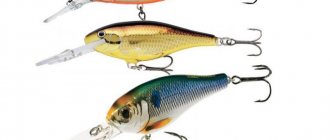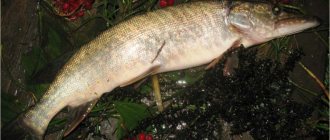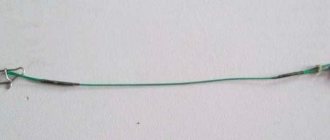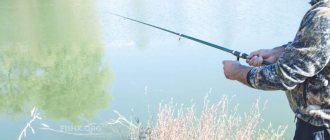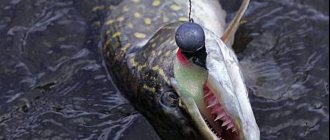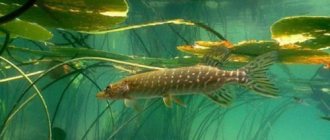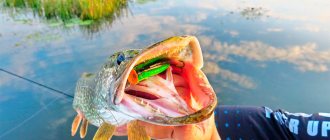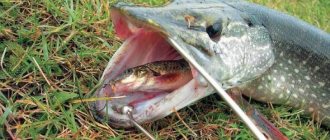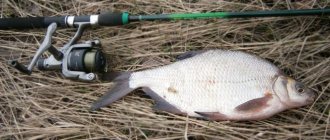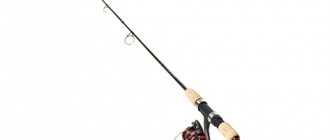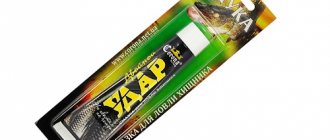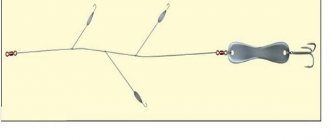Where do pike live on hot days?
The following places are considered to be favorite pike sites:
- shallow water;
- platforms;
- bushes;
- thick grass;
- driftwood;
- river bays teeming with juveniles;
- narrowing of water bodies;
- places where water lilies or reeds grow.
Important! If the weather is hot, then it is best to catch pike at dawn or closer to sunset, because... The fish bite best during these hours.
On ponds or lakes, pike are caught extremely poorly, because... in stagnant bodies of water, the water warms up much faster, and the fish are no longer as active. In such places it is best to fish during rain or in cloudy and windy weather. It is worth noting that the stronger the wind blows, the more oxygen it pumps. This makes potential prey more active and more receptive to various baits.
Advice! When going to a new place, study the surface of the water. After all, pike manifest themselves in bursts, and it is extremely easy to distinguish predatory fish from ordinary peaceful ones. In the morning, pike can go to places where people swim, because... natural food accumulates there.
Best time to catch pike, sunrise and sunset
The influence of weather conditions on the behavior of pike
It is difficult to say whether it has been proven through scientific experiments or whether these are personal observations of experienced fishermen, but pike really loves bad and cloudy weather. Moreover, it could even be a rainy day with little wind. It is worth remembering that before a thunderstorm, the pike begins to actively eat, which means that the predator still reacts to changes in atmospheric pressure. When it is low, it becomes more active, and when it is high, on the contrary, it stops eating.
As for the time frame, you can pay attention to the morning, when the sun is just rising, or the evening, when it is setting. Some fishermen report a successful bite at night, but this is rather an exception to the general rule.
Techniques for catching pike with a spinning rod in summer
The technique of catching pike using a spinning rod varies. It is best for novice fishermen to use a uniform and slow retrieve.
You can also fish for pike using a stepped retrieve or a twin-jig retrieve. During a stepped retrieve, the pike catches the bait as it falls, but a twin-jig retrieve can be characterized by twitching of the rod.
When choosing a fishing technique, you also need to pay attention to the water temperature, since pike are not active in the summer heat. Therefore, before choosing a fishing technique, you need to pay attention to weather conditions.
Spinning fishing
Spinning is a popular and dynamically developing form of fishing.
Fishing with a spinning rod involves the use of artificial baits to catch predatory fish (pike, perch, pike perch, etc.), but with spinning tackle you can also successfully catch peaceful fish (ide, chub, roach, dace, etc.).
There are many schools and trends in spinning that differ from each other in fishing techniques, baits used, and the type of spinning tackle and equipment itself. Spinning closely intersects with adjacent areas of catching predators using artificial bait. First of all, this is baitcasting (casting tackle with a baitcasting reel and a rod for it).
Selecting a spinning rod
When choosing fishing gear for shallow rivers, fishermen most often give preference to spinning rods. Fishing can be exciting, exciting and very successful. But in order for spinning fishing to be enjoyable, you need to choose the right equipment, taking into account the characteristics of the reservoir and the behavior of the pike.
The standard fishing kit, which is recommended by experienced spinning fishermen, includes:
- rod 2 - 2.5 meters long with a test weight of up to 20 grams, medium-fast or fast action;
- reel size 2000–3000, inertia-free, universal with a reduction of about 5.0:1, with good line laying and easy movement;
- braided cord and monofilament line with a breaking load of up to 4–6 kg, metal leashes.
It would be a good idea to have polarized glasses that will allow you to see what is happening underwater: the behavior of the bait and even individual pike exits.
Features of the tackle
In the modern world there is a huge variety of gear for pike fishing. Once in a fishing store, you can choose for a long time from the whole variety of offers.
The most popular tackle is spinning. When choosing a spinning rod for this predator, you need to be guided not so much by cost as by the correct characteristics.
Rod
The selection of a fishing rod should begin with choosing the optimal length. It depends on the fishing method. If you fish from the shore, then there is a need for long casting.
Accordingly, in order to cast the bait far, they choose a longer option, on average about 3 meters. When fishing from a boat, the issue of casting is not so pressing, so you can buy a shorter model, 2.1 - 2.4 meters.
The next thing you need to pay attention to is the material from which the rod is made. Professionals recommend purchasing carbon fiber tackle. Of course, you can choose other composite materials, for example, fiberglass, but they will not provide the required quality.
A rod with a test weight of 5-25 grams is ideal for all beginning fishermen. It is suitable for installing any baits:
- rotating and oscillating spoons;
- wobblers;
- jigs, etc.
With more experience, you will be able to select other fishing rods to suit your individual characteristics.
Coil
When selecting a coil, it is also necessary to take into account several parameters:
- body material;
- spool size;
- friction brake;
- bearings;
- gear ratio.
First you need to decide on the material of the case. You should not buy reels made of cheap plastic, because they can easily break during pike fishing. It is better to choose carbon, aluminum, or graphite options. The size of the drum (spool) is also important; you need to pay attention to the markings. It shows what line should be wound on the spool and what length.
Tips for a fisherman: How to catch pike with live bait in the summer - Tips for a beginner
The friction brake is needed to prevent large prey from easily unwinding the line on the spool. There are two types of brake: front and rear. Their operating principle is approximately the same, only the location is different. Its presence is extremely important for catching large pike specimens.
For some, the presence of bearings is a sufficient argument for buying a reel, while others want a large number of them. Their very presence is a sign of good quality and long service life.
fishing line
The variety of types of fishing line makes modern fishermen's eyes run wild. Pike fishing involves taking into account some parameters:
- color;
- thickness;
- strength;
- material.
Of course, you shouldn’t attach much importance to what color fishing line you use, however, professionals recommend following the recommendations. When using an oscillating spoon, it is better to choose a gray or marsh-colored fishing line.
If you use a jig, it is better to choose bright colors. If you need to control the wiring, it is better to use luminescent types (white or pink).
The thickness varies depending on the type of fishing for the “toothy” predator and the personal preferences of the fisherman. Typically, the optimal diameter is in the range of 0.12 -0.2 mm when fishing with small baits, and 0.3 mm when fishing with large baits. For pike fishing, a fishing line that can withstand 8-9 kg is usually enough.
The main materials used for the production of fishing lines are:
- monofilament;
- network;
- fluorocarbon.
Leash
There are a large number of leashes. Each has its own advantages and disadvantages:
Equipment
All selected components of the spinning rod must be fully compatible with each other so as not to get into an awkward position while fishing. The tackle set must be designed for a certain size of pike. It shouldn’t turn out that the rod and leash are designed for a “river giant”, and the line for a fry.
This is a natural clock that is worth listening to. They are much more reliable than biting calendars.
The principles for searching for pike sites in the spring vary depending on the type of reservoir and are as follows:
1. On the rivers
the predator usually hides under steep banks and can grab the hook at the end of the retrieve. Therefore, it must always be brought to the very end. If the river is small in width, it is better to throw bait on the opposite bank. Pike can grab them right away. In the spring there is no predator in a strong current, since it does not have the strength to fight the movement of water flows.
2. On deep lakes
At the beginning of spring, pike are found on shallows located along the shore, on shallow ones - under the shore, on underwater mounds. When the water warms up well, it will go further into the depths, into holes and ditches.
3. On the ponds
The predator stands near vegetation in any season, in snags, under flooded logs, in windows and corridors of aquatic vegetation.
4. On spacious reservoirs
In spring, pike prefers the coastal zone. At this time, carp species of fish spawn in the grass near the shore. The predator feeds on them. It goes to a shallow depth of only 30 centimeters to grab prey.
If fishing is done from a boat, it is necessary to fish shallow waters using light spinning rods with a flexible tip. When fishing from the shore in the spring, places up to 1.5 meters deep are selected, where there are shelters. For this purpose, blanks from 2.2 meters to 2.7 meters long, medium-fast and parabolic action with dough up to 20 grams are suitable. Equipment
you have to choose like this:
1. Inertia-free reel with sizes from 2300 to 3000. They must have a small additional bearing number. This will ensure faster catching of prey and increase the reliability of the reel.
2. Monofilament fishing line with a diameter of 0.2 to 0.24 millimeters. A braided cord with a thickness of 0.07 to 0.12 millimeters is also suitable.
3. Leashes. For pike fishing in the spring they are required. The best solution would be do-it-yourself twist leashes made from guitar strings. Their connection to the fishing line does not require additional elements, which often scare away the fish. The length of such leashes ranges from 15 to 20 centimeters.
In spring, a lot of pike can be found in the water meadows. Fish come to them with floods in search of a place to spawn. When the water subsides, the pike finds itself isolated from the main part of the reservoir, experiences a shortage of food and greedily rushes to any bait.
Individuals that have reached sexual maturity reach an average length of 50-100 cm. Thirty-year-old specimens can sometimes reach one and a half meters in length and weigh over 20 kilograms.
Assembling a spinning rod for your first fishing trip
It is, of course, worth starting with the selection of all the components of the tackle for the future spinning rod - the form (rod, reel, cord, connecting fittings).
How to choose a spinning rod - inexpensive, but not terrible
A few introductory points:
- A novice spinning angler will most often have to fish from the shore, and this is what we will start from when choosing a fishing rod.
- Since, most often, a beginner still has no idea where exactly (type of water area, depth) and what kind of fish he will have to catch (type, size), we will proceed from universal components for the middle latitudes of the Russian Federation and the CIS.
- At the initial stage, you should not buy expensive tackle and bait. You can catch a predator using mid-price gear, but the disappointment of spinning fishing along with the tidy sum spent can lead to depression.
The length of the spinning rod is selected based on fishing conditions, as well as the anthropometric data of the fisherman. Our opinion - a universal for coastal fishing for an angler 1.7-1.9 meters tall - a spinning rod 1.9-2.4 meters long.
There is an opinion that for fishing from the shore you need a longer rod than from a boat. In general this is true, but the reality and practice are different. So, it is extremely difficult for a beginner to master a length of more than 2.4 meters, and it is not necessary! This is especially true of our rivers - where each bank is strewn with bushes and trees, when you have to literally fight your way through the thickets to catch. This is when all the advantages of shorter forms come to light.
Based on the materials , the forms are:
- Carbon (carbon fiber) . Modern lightweight, tensile, but fragile forms. The top of the pyramid of quality spinning rods (especially high modulus graphite rods). The main disadvantage is the high cost and fragility.
- Fiberglass . Relatively cheap. Quite durable and tenacious. The downside is that they are heavy and not as sensitive as composites.
- Composite . A mixture of the first and second options. Some kind of universal, but like everything in life, you find it somewhere and lose it somewhere. You need to look based on a specific “stick”.
For a beginner, we recommend choosing either fiberglass or a composite blank. It is especially worth paying attention to used models, which are often sold by more experienced spinners who switch to expensive carbon models.
Blanks for spinning rods can be telescopic and composite (one or two private ones, rarely more). The first option is almost always fiberglass. It is the best option for a beginner in fishing in general. It is compact, durable, always ready for combat, and is suitable for the weekend fisherman. I threw it into my backpack, jumped on my bike and rode to the river/lake.
If you are an experienced fisherman, for example, a bottom fisher, who wants to master a more sporting method of fishing, then it is quite possible to purchase a plug rod. But keep in mind that such a fishing rod is less compact and it is more difficult to deliver it safely to the reservoir.
Telescopic spinning rod
Plug rod
By class , forms can be ultra-light, light, medium, medium-heavy and heavy. To begin with, you should choose a light rod with a test weight of 2-15, 5-21 grams. This is a universal form that allows you to work with most of the main classes of lures that a beginning spinner in central Russia should master - spoons, silicone, light wobblers.
Interesting to know! On any form of higher or lower quality, a test is indicated for the weight of the baits being thrown (in grams or ounces) and for the recommended cord/line (in grams or ounces). Proper selection of cord to the blank will not only allow you to cast the bait as far as possible and make high-quality animation, but also avoid breaking the rod.
When building your first spinning rod, it is better to choose fast or very fast (fast and ultrafast). This is the best option for fishing with wobblers, jigs and spinners.
Spinning fishing technique
Pike are caught with a variety of different styles of retrieve. Beginner spinners are advised to fish with a slow and even retrieve.
The next type of wiring will be wiring with short breaks and nods of the rod tip. It is fashionable to supplement such wiring by changing the speed of the bait.
When using stepped wiring, it is necessary to take into account that the pike attacks at the stage of falling bait or when it moves horizontally. That’s why they alternate several turns of the coil with a long pause. They do it this way: after the bait touches the bottom, they begin to rotate the reel again.
There is also twitching wiring. It is carried out by simultaneously twitching the rod with a uniform movement of the wobbler thanks to the gradual reeling of the fishing line. This twitching forces the wobbler to move from side to side, increasing the fishing area.
Pike fishing varies depending on the season and location.
By season
in spring
Pike are caught in the spring, starting from the melting of ice and the spawning of predators. After this, her bite improves.
Make precise casts to the areas where small fish are rutting with pike. The baits used are light and small, which are designed for a depth of up to 2 meters. This can be a wobbler, soft bait, or both types of spoons.
The bait is moved evenly with light twitches and short stops.
In summer
This fish is often found in the thermocline. A thermocline is a sharp boundary between the water temperatures of the upper and lower layers.
They use walkers, wobblers, poppers, various types of spinners, twisters, spinnerbaits, and low-load vibrating tails.
The most convenient way to find out the depth of the pike is with a wobbler with a known diving depth.
As a tip, when trawling predators in the grass, take spinnerbaits, non-snagging spinnerbaits and silicone baits.
in autumn
This is the best time to jig and use deep baits (deep-water wobblers and spinners).
Wiring is done trolling or stepped. When fishing by trolling and casting jigs from a boat, take a rod up to 2.4 m. For fishing from the shore, from 2.7 m to 3 m.
Large individuals are often caught a week before freeze-up.
With and without current
Pike stay closer to the bottom. Choose a heavy bait that sinks quickly or a wobbler with a large blade that forces the wobbler to quickly dive to the bottom. Catch, gradually reducing the depth of immersion of the bait. Casts are made in a fan pattern at river bends or parallel on a straight shoreline.
Let us describe a method that allows you to avoid snags: after casting the bait for the first time, count down: 101, 102, 103, 104, 105, etc., until the line slackens. Suppose the last number was 112, then next time they count down to 111 and begin reeling in the fishing line.
From the boat and from the shore
The spinning rod is 2.7 m long for fishing from the shore, and 2.1 m long for fishing from a boat, respectively.
The shore fisherman should approach the water very carefully, starting with short casts.
The test and system will depend on your chosen baits:
- Wobblers weighing 5-10 grams, rod action choose fast and medium.
- Jigs and massive spinners - up to 40 gr., action - slow or medium.
It is always better to experiment and take with you two or three new wobblers for catching pike on a spinning rod to test the catchability of these baits. It also often happens that in one body of water a toothy predator takes on some wobblers, but in another body of water it no longer takes on them and bites on others.
Bait Definition
Wobblers for pike fishing come in floating, sinking and suspending types. The first two categories are completely clear, but the third type is of increased interest. This is nothing more than a material with neutral buoyancy. Such artificial nozzles have a blade that determines the depth. The bait works in one horizon, which opens up new opportunities in catching a passive predator.
Modern wobblers are made from the following materials:
- plastic or polycarbonate;
- polypropylene, similar to dense foam;
- heavy wood species.
Polycarbonate is used in 85% of cases because it is hard and suitable for lure requirements. Wood and polypropylene also have a niche, but are not as valued. Marks from pike teeth remain on the soft structure, which spoils the product. In addition, it is difficult to create several wooden products of the same weight due to the heterogeneous structure and density.
Initial set of baits for beginners
This is where even an experienced fisherman can get confused. Diversity is both pleasing to the eye and frightening. Our advice is not to be too scattered, not to go to extremes and select a set of baits to suit your gear.
It is worth having spinners (rotating and oscillating) in your arsenal - this is the first class of bait that is worth paying attention to. Using the links above you can select the most working and versatile rotating and oscillating spoons. It’s worth starting with such spinners - they are the easiest to “train” and are most understandable to a beginning spinner.
Mepps spinners
We recommend purchasing several different sizes of spinners and spinners in several different variations - we select the weight for the form, the size for the intended fishing object and the type of reservoir.
It is also worth purchasing several types and sizes of silicone baits - twisters, rippers, worms. More information about choosing tires for perch is here, but it can also be used as a universal recommendation.
Hard installation
And finally, it’s worth purchasing several types of wobblers. Don’t immediately rush out and buy expensive Japanese wobblers. You can get by with quality replicas from Spro, Kosadak, Lucky John and others. It is also worth browsing specialized forums at the time of purchasing a used vehicle (you can also read reviews there and the nuances of using a particular model).
Yo-Zuri L-Minnow - we recommend it as one of the first wobblers for beginners
The first time we go out on the water, we take 2-3 spinners in standard sizes 1-3 according to Meps, a pair of silicones and weights from 3 to 8 grams, 2-3 crankbait wobblers and a minnow 3-7 cm and weighing around 6-10 grams. For starters, that's enough! You will understand, feel, fall in love with one or two types of bait, then you can “grow over” it.
How to choose a wobbler for pike fishing
A fisherman's box should have bait for all occasions. There is no universal nozzle that works in all conditions, so you will have to adjust it directly on the shore of a lake or river. The choice of wobbler depends on the reservoir, the depth of a particular area, underwater vegetation and obstacles, currents, and weather.
Size
Pike has an impressive mouth with many teeth, so small wobblers are not always used. The size is also affected by seasonality: in cold water, experienced fishermen recommend using smaller models than in the warm season. Individuals up to a kilogram are caught on bait of any size. Sometimes the “toothy” one attacks 2-inch perch silicone.
When going after a trophy specimen, arm yourself with wobblers measuring 120-130 mm, since a seasoned pike will not waste energy chasing “trifles.” A predator of 3 kg or more often lives on the edges of the riverbed rather than in the thickets of shallow water.
Colors
The choice of bait color depends on weather conditions, seasonality, water transparency, and fishing location. On a clear day, the dark and natural spectrum works better: “olive”, “machine oil” or “ultraviolet”. Cloudy weather similarly changes the color scheme in the opposite direction. Light ones perform better when the sky is overcast. A similar situation arises with other conditions.
Transparent water is optimal for natural colors, and cloudy water is optimal for light and acidic shades. When choosing bait, adapt to specific fishing areas. Each body of water is unique, so experiment often.
Form
The structure of the predator’s strong jaws allows it to feed not only on fish, but also on frogs, waterfowl rodents, and birds. Unlike pike perch, which can handle elongated minnows, pike readily responds to cranks, shads, fats, and imitations of wide-bodied fish. In addition to classic models with a blade, the market offers baits without it - rattlins, poppers. The former work in the lower water horizons (bottom layer), while the latter work exclusively on the surface.
Pike fishing on the lake
Let's go fishing for lake pike. After all, this fish is one of the most common predators of freshwater bodies of water, an object of all-season, exciting and exciting fishing. Pike fishing has long been transformed from a simple activity into a kind of “religion,” and spinning rod “pike fishermen” have become its adherents.
Lake pike fishing is the best choice for beginners
But before they really “get sick” of fishing for such a strong and cunning predator as pike, many beginners have to look for their fishing happiness for a very long time in various bodies of water, losing bait on unfortunate hooks, damaging rods with inexperienced casting, hooking and ultimately leaving go home with an empty kukan. Many, after several such fruitless fishing trips, lose interest in pike fishing and switch to other, more reliable and trouble-free fish. But, as a rule, such a loss of zeal is not due to capricious and changeable weather, poorly configured gear, or even a lack of experience - from my own experience I can say that the choice of the first place for pike fishing is very important for a novice freshwater barracuda hunter.
From the same rich fishing experience of pike fishing, it follows that the best place to master all the basics and intricacies of this activity is a lake - small or large, of various shapes, degrees of flow, depth. The main thing is that there are pike in it. It is about fishing for lake pike that we will talk in more detail in this article.
Pike biting calendar
The pike bite in the lakes is most active:
- in the spring for several weeks before spawning,
- from the end of summer until the onset of November bad weather,
- along the first and last ice.
Periods of weak bite, and sometimes complete lack of bite, occur during the summer heat and deep winter. If we talk about the most catchy time of day, then in each reservoir it is different - in some the pike takes early in the morning or late in the evening, while in others there can be a good bite in the middle of the day.
The exception to this situation is the pre-spawning feast in the spring, when in most lakes the bite can last all day with short breaks.
Where to look for pike in the lake
Lakes, unlike rivers, do not have a pronounced current. Masses of water move extremely rarely - this happens only with a large influx of melt and storm water into the reservoir. The rest of the time there is no current in the lakes. This fact greatly simplifies the search for pike. And if in rivers and deep streams the predator constantly changes its parking places, then in the lake the pike leads a sedentary lifestyle.
Lake pike loves most all kinds of bottom irregularities (pits, depressions, plateaus in the depths), flooded snags, bushes, areas near aquatic vegetation, grass islands). In such places, pike waits for small fish swimming past and hides from the summer heat.
Very often, the presence of a pike in a particular place can be determined by the characteristic splashes with which the predator accompanies each of its attacks.
Tackle for catching lake pike
1. Among the gear for catching pike in lakes, spinning takes the lead both in catchability and in the excitement and excitement of fishing. A pike spinning rod is a blank with a medium or fast action and a test weight of 10-30 grams, equipped with a reliable high-speed spinning reel (gear ratio 6:1 or more), guide rings with metal-ceramic inserts.
2. The spinning rod is equipped with thin monofilament line, matching the color of water, aquatic vegetation, with a cross-sectional diameter of 0.22-0.35 mm. They begin to use braided cord when it gets warmer, since in cold weather the braid becomes very stiff, insensitive, and damages the fingers when releasing caught baits.
3. A metal tungsten leash with a swivel and clasp is required when equipping spinning tackle.
4. The best lures for fishing on the lake are oscillating spinners with a wide petal, rotating ones with Aglia and Komet petals, non-snagging ones (Rapala Minnow Spun), crank and shad wobblers with active play, minimally loaded large ones silicone baits.
In addition to the popular spinning rod, floating summer girders (“circles”) are also used for catching lake pike.
Lake fishing technique
Spinning fishing involves fishing promising places using different depths and fishing speeds:
- slow bottom retrieving (after casting, retrieving is carried out at low speed with the expectation that the bait moves slowly 5-10 cm from the bottom);
- fishing “at half-water” at an average speed (the fishing speed is higher than for bottom fishing, the bait moves in the middle water horizon at a depth of 1.5 to 2 meters);
- stepwise retrieving (after 5-6 revolutions of the reel handle there is a 2-3 second pause, as a result of which the movements of the bait resemble a wounded fish).
Alternating between different types of fishing, they select the most catchable one for a given lake. Pike bites are sharp and strong, often indistinguishable from hooks, so with any suspicious strike it is necessary to make a short and strong hook. If the hook has reached the target and the pike is hooked, then it is necessary to very carefully pull it to the shore, holding the spinning rod at an angle of about 60 degrees relative to the surface of the water, releasing the line when the fish jerks strongly with a correctly adjusted friction brake of the spinning reel. This position of the rod will allow you to evenly distribute the load on the line and the rod.
Pike fishing on the lake (video)
If after 8-10 casts there were no signs of predator activity (grabs, strikes), then move on to the next place.
Fishing with floating girders is not as dynamic as spinning, and consists of setting up girders baited with juveniles using a boat near thickets of coastal aquatic vegetation and waiting for many hours for bites in the distance of the girders. If the pike has taken the fry and started to unwind the line from the circle, they carefully, without unnecessary noise, swim up to the vent and, having intercepted the line, make a short and sharp hook, putting the disk of the vent into the boat. The main thing when fishing for pike is not to give it the opportunity to go under the boat, since in this case there is a very high probability of getting lost.
When fishing with mugs, the pike is removed from the water with a hook, or by placing your fingers under the gill cover.
- Pike hunting with a trap ⇩
- The principle of operation of a trap ⇩
- Benefits ⇩
- Disadvantages ⇩
- How to charge a trap? ⇩
- Installing a trap ⇩
- Summer ⇩
- In winter ⇩
- What to look for when buying a trap? ⇩
- Make a trap yourself ⇩
- What will you need? ⇩
- Manufacturing process ⇩
- The process of catching pike in a trap ⇩
- Reviews ⇩
Many fishermen strive to catch one of the most cunning predators of the reservoir - pike. This fish is quite careful in its actions, it is the most formidable predator of the reservoir, it is quite difficult to catch it, since during fishing the pike strongly resists. There are quite a few different methods of catching this fish, among which we note the use of traps.
This outlandish tackle appeared back in the 80s; it was originally used by Finnish fishermen. At that time, there was practically no more effective tackle than a pike trap. Over the years, quite a lot of models have appeared; some craftsmen make them with their own hands. Let's consider all the features of using this unusual gear.
Pike hunting with a trap
As previously noted, pike is a cautious fish, but very voracious. Due to the high activity in the reservoir, it feeds abundantly, which also determines the large weight of trophy specimens that can be caught precisely with the help of the device in question. To begin with, you should take into account the predator’s preferred habitats – washed-out banks and reed thickets.
When choosing a location for installing gear, you should pay attention to the following points:
- Preferably it should refer to water bodies where a relatively small number of fishermen fish. Due to great caution, the fish can avoid the trap, since the structure is quite large and difficult to disguise. Even in muddy water or in thickets, the structure can alert a predator.
- Small rivers that have quite a lot of snags at the bottom and deep holes are the most attractive place for fishing, since under such conditions fishermen with fishing rods do not fish.
- The design features mean that you can fish at any time of the year; pike can be caught in different sizes. If, when using a trophy fishing rod, a specimen may break off because the tackle did not match the fish, then in this case this will not happen.
The principle of operation of the trap
The operating features of the design in question include the following points:
- The mechanism is made of durable, often stainless steel. It is triggered at the moment when the fish bites the installed bait. The peculiarity of using this design is that the chance of a predator escaping the trap after biting is zero, since when it is triggered, in many cases the fish dies due to injuries received.
- The design is quite simple, consisting of several elements: Spring.
- The lower and upper teeth have pointed tips.
- Guard or retainer.
- Fishing line.
There are quite a few models of the product in question, many weighing up to 20 kilograms.
Advantages
The advantages of using the gear in question include the following points:
- To use the tackle, you do not need to have a lot of experience and skills, the main thing is to be careful when setting it, since the tension force of the spring is very large.
- Can be used for fishing at any time of the year and under almost any conditions.
- Unlike using a fishing rod and other gear, the mechanism in question can be used to catch pike of any size.
- If the gear is set up correctly, the risk of a predator falling off is reduced to almost zero.
- The design is reliable, lasts a long time and rarely fails.
As previously noted, there is practically no more effective gear when hunting for pike.
Flaws
A pike trap has several disadvantages:
- When installing it, you should be careful, since due to the large force exerted by the spring, when the structure is activated in your hands, there is a possibility of causing severe harm.
- The weight of the product reaches 20 kilograms, which significantly complicates transportation and installation.
- Due to the large dimensions and the use of steel in manufacturing, which determines the occurrence of reflections, pike can move away from the bait. If there are often fishermen in a reservoir, then the pike becomes more timid.
- Many fishermen consider the use of a trap to be a type of poaching, but the state allows the use of such gear in limited quantities.
- The fishing process itself in this case does not bring pleasure, but the result is much happier than when using a spinning rod.
How to charge a trap?
Charging process:
- The upper fixed prong is healed with a retainer, and bait is put on the lower one, which becomes a small fish.
- Particular attention should be paid to the correct placement of the bait: the prong is passed under the skin from the caudal to the dorsal fin. Skilled fishermen achieve a result in which the bait shows signs of life for another 2-3 hours. During the feast or in winter, you can also use frozen fish. For a more secure fixation, you can screw the fish to the prong with wire.
Installing a trap
In summer
In summer, recommendations for installing gear are as follows:
- To begin with, the fishing line is tied.
- After this, the bait is planted.
- The length of the fishing line is selected taking into account the casting distance or the depth of lowering the trap. In some cases, after the mechanism is triggered, the fish remains alive; a small supply of fishing line will not allow it to escape.
- They tie it to reeds or other vegetation, pegs - the main thing is to make sure that they are well secured.
- Depth of lowering the bait: half-water or to the very bottom. The predator in question rarely approaches the surface in the summer.
- Some fishermen leave the bait for several hours or days, since once the mechanism is triggered, the pike will not leave. It is quite important to use a strong fishing line.
in winter
In winter, the staging process is even simpler than in summer. When the surface of the water is covered with a thick layer of ice, you should make a hole, tie the mechanism to the fishing line, and attach a pole to the fishing line at the other end. After this, you can attach the bait and lower the trap, and leave the pole on the surface - located across the hole.
What to look for when buying a trap?
The gear in question can be purchased or made independently. When purchasing, you should pay attention to the following points:
- The size of the structure depends on what size bait will be used and what size the intended prey will be.
- Brass versions are suitable for small fish; for large predators, you should choose models made of steel.
- On sale you can find models with 2, 3 teeth, which increases the efficiency of the gear. The design may also have a pin for bait, which significantly facilitates the process of attaching it.
Make a trap yourself
What will you need?
If you have some plumbing tools, you can make your own gear. To do this you will need the following materials:
- Two steel rods.
- Hard tempered wire.
- Durable steel spring.
- Fishing line.
Some people use electrode rods as rods.
Additional equipment
If you have made it clear that fishing with a spinning rod is your confession, then we recommend replenishing your arsenal not only with new gear and lures, but also with the following devices and uniforms:
- landing net (pickup) - especially important when fishing from high coastlines;
- extractor for removing bait from the mouth of a pike;
- a vest for storing boxes of bait, wire cutters, spare spools and other small items;
- wader - for wading fishing;
- wire cutters for working with fishing line/cord;
- lipgrip for catching fish;
- Polarized glasses cut off the glare from the water on a sunny day and allow you to see underwater obstacles and fish the bait better.
In order not to be disappointed in spinning fishing, you should not immediately rush after a trophy pike or asp. Start with the bass and the ubiquitous grass pike - feel the taste of success, feel the bite and the resistance of the predator.
Also, don’t start with expensive and delicate gear - expensive Japanese blanks and reels, ultra-thin cords and expensive wobblers at 20+ USD apiece. Graduality and moderation are the path to becoming an accomplished spinning player.
Fishing technique and tactics
Fishing in shallow rivers has its own specifics. There are some rules, following which a spinner can boast of an excellent catch. Important criteria are:
- choice of location;
- movement along the river;
- approach to the place.
During the spring activation of pike, it can be caught almost everywhere. Then, after spawning, she calms down and stands in one place for hours.
It is necessary to choose an approach in which there is a lot of coastal vegetation, preferably the presence of snags and fallen trees. It is at such points that pike arrange ambushes. Sometimes such approaches are inconvenient and seem difficult to achieve. But there are “fishing spots” there. If you are not lazy and make your way to a hard-to-reach shore, you can enjoy active fishing and a good bite.
In order not to scare the pike, you need to approach the fishing spot as silently as possible. The first test casts should be made close to the shore in order to thoroughly probe the coastal strip. Then you can move forward.
If the place is inaccessible from the shore and you need to walk through the water, then you should move with the flow. Sometimes fishermen notice that fish move away from the shore because a person made too much noise and scared them away. This type of pike is considered lost and will treat bait with great caution.
Video: Spinning pike on small rivers
The basics of spinning fishing on small rivers are perfectly covered in the following video. From it you will learn what kind of gear you should have, what bait and equipment to take with you to the pond, which river areas are the most promising and how to fish them.
Features of fishing in spring
Spring fishing has its own nuances. Usually, pike go out to spawn after the ice has melted and the water has warmed up to a temperature of +4 to +9°C. You can’t count on a good catch during spawning: the fish are sluggish and passive. But immediately after spawning, the golden time for fishermen begins - the spring zhor. During this period, the “spotted” one grabs any bait without thinking.
Pike bite consistently well in May. In low-water rivers, by this time the water is well warmed by the sun, and small fish, its main food, are active and playful.
Spring pike goes hunting and attacks various baits. Usually it stands in shallow water, waiting for prey that goes to spawn.
By summer, the pike becomes lazy and is active only at dawn. The feeding schedule is improving, and she is no longer ready to grab any thrown bait. Preferred weather is cloudy, rainy days.
Early spring in March, April
After a long and cold winter, the pike is hungry and when the first warm days arrive, it tries to replenish its energy reserves. Spring zhor is the most favorable for fishing. The first zhor begins when the ice is just melting and has not yet left the river. This is the pre-spawning activation of pike. Then, when the ice breaks up, the fish go to spawn. During it, you can forget about hunting - the predator stands still. Then comes the peak of activity, during which you can catch an average of 10 tails per fishing trip!
Video: Fishing for pike in early spring with a spinning rod on small rivers
Where do pike spawn in small rivers?
Pike spawn closer to the shoreline at a depth of no more than 1 meter. This is due to the fact that in these areas the water warms up quickly. The bottom should be muddy, with natural debris - leaves, mud, shrubs. Also, as a laying site, the toothy one chooses banks overgrown with sedge and reeds.
Often, pike spawn at points of river flooding, which for natural reasons leads to the death of the offspring. The water enters the banks, and small pike remain on dry land. They are quickly eaten by birds and animals.
Fishing on a small river is an exciting activity that can bring a lot of positive emotions. And the right gear, knowledge of the habits of the spotted predator and the choice of suitable bait are also a good catch.
Features of summer fishing
Pike is weakly active in warm water; as the water temperature increases, its activity decreases. In addition, in the summer the amount of natural food increases and it is extremely difficult to surprise a predator. Fish scatter throughout the reservoir in search of numerous small fish. All this leads to the fact that the predator is more difficult to catch. Good luck awaits those spinners who practice constant movements and change baits.
Fishing can bring good results in early June, when the water has not yet warmed up enough. In July, when the temperature changes significantly, it is extremely difficult to find pike in the same place, since the predator finds places with more comfortable conditions. With the colder weather at the end of summer, the location of the pike changes again. Thus, during the summer months, the fisherman needs to constantly be on the lookout for new promising places.
How to catch pike with a spinning rod in summer
Fishermen on boats have a better chance of successful fishing. This is the only way to find the most promising places for pike fishing. Having a boat is especially important from July to mid-August, when the fish move from shallow water to shady and deep places.
Features of pike fishing in summer
Despite the gluttony of pike, in the summer, and especially on hot days, it is difficult to predict its behavior.
On the one hand, it tends to the depths, where the water is colder, on the other hand, the rapid proliferation of algae reduces the amount of oxygen in the water and forces river inhabitants to stay near the surface.
In addition, the meager, inconsistent bite is provided by a large number of fry : the predator does not experience a nutritional deficiency. Despite this, pike fishing in the summer months can be quite successful if certain features are taken into account. The skill and dexterity of the fisherman certainly play an important role, but external factors should not be underestimated.
These factors include weather conditions.
The predator loves inclement weather , cool cloudy days with partly cloudy skies, not very strong winds and even rain - the ideal time for hunting pike.
When there is a strong wind, fish are caught with varying success, but on the eve of a thunderstorm there is a surge in pike activity . The only pity is that the Hydrometeorological Center, as a rule, predicts a storm warning much later than the river inhabitants feel it. In hot weather, it is most convenient to guard the predator in natural narrowings of reservoirs: in these places the water is maximally saturated with oxygen and a huge number of fry are concentrated.
The most “fruitful” time for pike fishing is directly related to the air temperature: in summer, it is best to spend the morning hours on the pond , starting from sunrise (about 4-5 a.m.) until about 8:00, although sometimes bites can last up to 11 s at intervals of a couple of hours.
The second wave of “exits” begins approximately after 15:00 and lasts until sunset.
Consecutive bites can be observed for 15-20 minutes, after which there is a pause. The time and number of “outings” of pike can vary significantly in different bodies of water, so the numbers are relative.
For example, some fishermen claim that they successfully catch pike at night, but usually in the dark in the summer they are caught more as an exception to the rule.
A change in atmospheric pressure affects the behavior of any fish: pike prefers stability or a drop, and the sharper the mercury reading drops, the more intense the bite will be. The chances of successful fishing increase if a drop in pressure (even a slight one: 2-5 mmHg) occurs after relatively stable values that last for several days. It is this fact that determines the active behavior of the predator before a thunderstorm: the fish senses an approaching cyclone with low pressure and a thunderstorm front and begins to feed intensively. During the period of stabilization of pressure, the bite can continue for several more hours, gradually declining.
Growth and increased atmospheric pressure are the main reasons for the complete refusal of food by the predator.
Fluctuations in the earth’s magnetic field are also not in favor of the fisherman: a couple of days before a magnetic storm, sensing its approach, the pike begins to feed intensively in order to spend the moment of increased solar activity in peace. People who are not weather sensitive rarely track magnetic fluctuations, which means it is not easy to predict a good bite. However, a sharp deterioration in weather caused by an approaching cyclone is always announced in the forecast, and this is an additional reason to try your luck on a reservoir, because... the predator is also susceptible to the approach of bad weather .
It has long been known that animals adhere to a greater degree to the lunar cycle , reacting to changes in lunar phases with their behavior. Numerous studies and observations have led to the conclusion that pike are absolutely not susceptible to outside influences during the full moon. But, 2 nights after the full moon, sensing the onset of the 17th lunar day, the fish becomes more active and behaves in this way for 4 days until the 21st lunar day. The second period of activity was recorded from the 1st to the 7th lunar day - the period of the young waxing moon.
External factors should also include the hydrological characteristics of the reservoir: sudden changes in water level are not provided for by nature, so every such situation is stressful for the fish. Pike, getting used to new conditions, abstains from feeding for 1-2 days. This should be taken into account if fishing is planned near reservoirs and hydroelectric power stations.
What difficulties can await a beginner?
Among the main problems, especially relevant for a beginner, are snagging on underwater and surface obstacles, fishing in strong winds, incorrectly adjusted clutch and related problems.
Situation one - getting caught underwater
In no case do we use forceful movements with the rod or reel - this is fraught with damage to both, and a bait located at a short distance can shoot at the fisherman - which is very dangerous.
The solution is to use a release where possible, if this is not possible. then you should wind the cord around a stick/plastic bottle in several parallel turns and smoothly!!! try to free the bait from the chain by pulling. It’s better to lose one lure than the whole gear, isn’t it?
As a separate frequently encountered option - hooking on water lilies. In this case, short, relatively sharp twitches of the cord with the rod are permissible - the root is broken and the bait is released.
Hook on a tree/bush
Catching a predator with a spinning rod is often accompanied by beginners casting it into the crown of a tree or large bush. In this case, the result will almost always be the cord getting tangled in the branches, when the bait can even hang in free fall. In this case, you can’t just pull with a rod at all. Since the weakest element, the knot on the clasp, is located below the point of the flail. There are two options - climb the tree or cut it as high as possible.
Under no circumstances should you cut off with jerks! This is dangerous for both the equipment and you!
Fishing in the wind
Windy weather leads to the previous situations even for experienced spinners. To avoid problems, you can wait out the peak of the storm. It also helps to cast as low as possible in relation to the water, in which the loop of the braid is blown out as small as possible. Also adjust for wind when choosing where your bait will land. A loop of line lying on a row of water lilies or a row of coastal bushes is a big problem and can ruin the whole fishing trip.
Special fishing style
The first, perhaps the most important condition for hunting for large pike is that you should not catch this fish like all anglers. It’s true, how could an ordinary pike grow to a meter in length if it were hooked by all fishermen, even those who picked up a spinning rod for the first time. As a rule, large specimens of pike either simply pass by countless baits without even paying attention to them, or do not bite due to the wrong time for fishing, inappropriate wiring and fishing style.
How to catch a big pike?
When going out to hunt for large pike, you should under no circumstances pay attention to small pike. You need to focus all your attention on catching a toothy predator of exclusively trophy size. Appropriate motivation plays a very important role on every fishing trip, so you must concentrate and set yourself an exact goal that you will confidently strive for throughout the entire fishing trip.
And so, below you can read some useful tips for successfully catching a meter-long, truly trophy pike, which is a desirable prey for all spinning anglers.
The bait should be big:
Very often, many fishermen are concerned about whether the bait is too big for catching a toothy predator? But not everyone will ask themselves, isn’t it too small? Lures 10 cm long compared to large pike are related like a mouse to a lion. Such small baits never whet the appetite of a trophy, meter-long pike, because... she loves to hunt exclusively for large prey of impressive size.
Fish away from the shore:
The behavior of a typical pike fisher, as a rule, is that he fishes in every possible way the accessible part of the reservoir only along the edge of the reeds or along the coastline, never reaching the point of fishing a hundred meters from the shore. Of course, if the reservoir is very small, then fishing for large pike can be carried out near the shore. But if fishing takes place on a large, spacious lake, you cannot do without a good watercraft.
Fish in places with great depths:
As a rule, large meter-long pike are found only in deep-water areas of the reservoir, coming to the surface of the water only in rare cases when it lacks food or air. Based on this, you should allow your bait to sink to the very bottom of the reservoir, where a predator will willingly wait for it.
Use unique baits:
Do not take the common wobblers and vibrating tails for fishing, which your colleagues use to catch 300-gram “laces” almost every day. Try to choose something special, something unusual, but at the same time effective and interesting for the toothy hunter.
Pike lures for spinning fishing
Such classic lures as oscillating and rotating spoons are still used by spinning anglers, despite wobblers and silicone baits.
Pike are more suited to low-frequency play and a spoon, if it is of high quality, is almost irreplaceable, considering that it can cost much less. In addition, it is easy to make and many spinners make it with their own hands. Unfortunately, you can’t fish with spoons everywhere, so you should pay attention to wobblers. There are three types of wobblers:
- Floating;
- Neutral buoyancy;
- Drowning.
We can safely say that you can choose a wobbler for all occasions. Wobblers with positive and neutral buoyancy are widely used. They allow you to fish large areas, including thickets and snags. Minnow wobblers are very popular when fishing for pike. These are long, narrow-bodied fish of varying lengths. For a regular pike, you can take a wobbler up to 7 cm long. If you plan to catch larger specimens, then wobblers 10-12 cm long are suitable.
Twisters and vibrotails
These silicone baits, both regular and edible silicone, are mainly intended for jig fishing in the spring and autumn, when the fish stay at depth.
Tips for fisherman: What are the best leashes for pike fishing - How to best use them
Spinners (rotating spoons)
They can provoke a toothy predator to attack. They are effective when the fish is actively searching for potential prey. It should be remembered that turntables are designed for continuous wiring. This narrows the scope of application of turntables.
Spinnerbaits
A very interesting bait that cannot be classified as simple. It is best to use it when there are signs of lethargy in the fish in order to provoke it to attack.
A specific pike bait is also a spinnerbait, which combines a rotating blade mounted on a rocker with a hook hidden in a shaggy “skirt”. The spinnerbait is used to fish shallow water and places among the grass.
